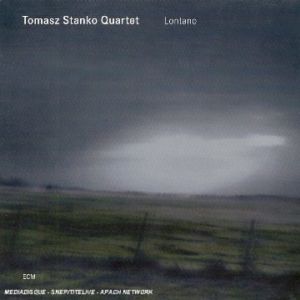AMG Review by Thom Jurek (4):
The change of direction on Lontano, the third release by Polish trumpeter Tomasz Stanko and his three young collaborators — Marcin Wasilewski (piano), Slawomir Kurkiewicz (bass), and Michal Miskiewicz (drums) — is startling. Whereas Soul of Things (2002) and Suspended Night (2004) focused on Stanko's increasing sense of balladry and structurally harmonic, assonant atmospheres, Lontano showcases a band confident enough after playing for five years to find real space for free improvisation. Recorded in the south of France instead of Oslo, producer Manfred Eicher works his name magic and allows stillness and silence to play as much a role as the performers engaging one another musically. The opening title track is the first of three such excursions with the title "Lontano." Here, Wasilewski's piano opens the door and allows for the band to haltingly and carefully enter the tune, contributing economically until a groove eventually develops out of one of Stanko's balladic ideas. Ever so slowly the beat becomes circular and focused, the band vamps on it, gradually gaining in intensity until it threatens to fall apart. But it never does. Instead the band winds it way back down into silence. "Cyrhia" begins as a thoughtful, hesitant ballad, but once more finds its way out into the world, entering it as a near-modal blues. "Kattorna" was originally performed by the Krzysztof Komeda group on its influential — and groundbreaking — album Astigmatic in 1965. Its angularity has been rounded off, but its sense of adventure is retained and Stanko's own economical style on playing, and then playing around its lyric line, is impressive, as is Kurkiewicz's empathic bassline. The other two "Lontano" pieces, at the middle and near the end of the disc, represent a kind of improvisation that actually sings. The interplay between the trio members and Stanko is instinctive. It's not nearly so hesitant and ranges farther than on "Lontano I." Lyricism and melodic ideas are never sacrificed in this kind of improvisation, but the playing is so free it nearly leaves the realm of jazz altogether. This is outside playing with heart, tenderness, and quiet beauty in its marrow. The silences on "Lontano III," are so vast, it's as if the listener can enter and remain inside any one of them. Indeed, this is music as poetry itself, a pure language at once crystalline and dreamy. The set closes with "Tale," a piece Stanko recorded on his ECM debut in 1975. This version reflects restraint in its more euphoric spaces. The idea of story comes from the slowly unfolding piano chords of Wasilewski, who urges the trumpeter on to solo until the end, not so much of the piece, but until the story is complete. Lontano is at once the distillation of 40 years of European vanguard jazz history, and at once the key in the door of the lock where it enters the world not as a music categorized by its instrumentation or personnel, but as music itself; where harmonics, space, and the improvisational language expressed in it transcends genre and classification. This band is simply astonishing, and Lontano is their most adventurous and cohesive recording yet. |

